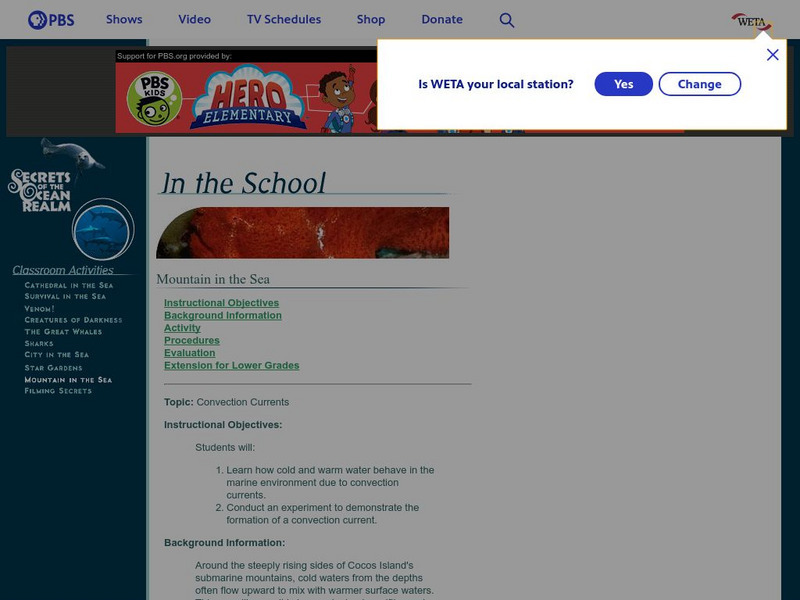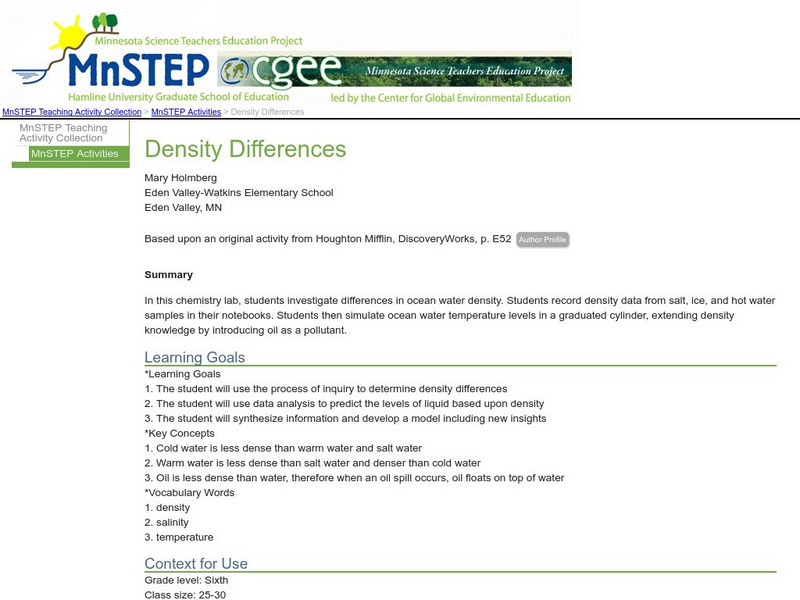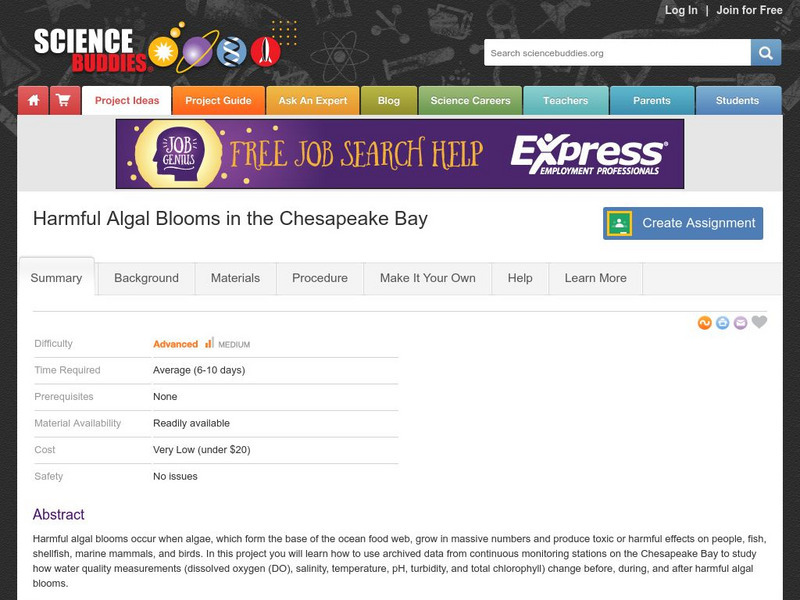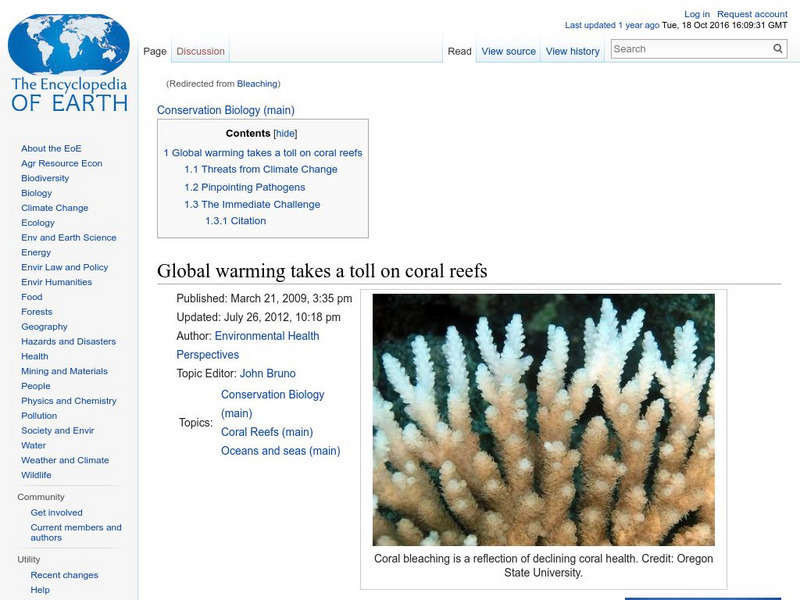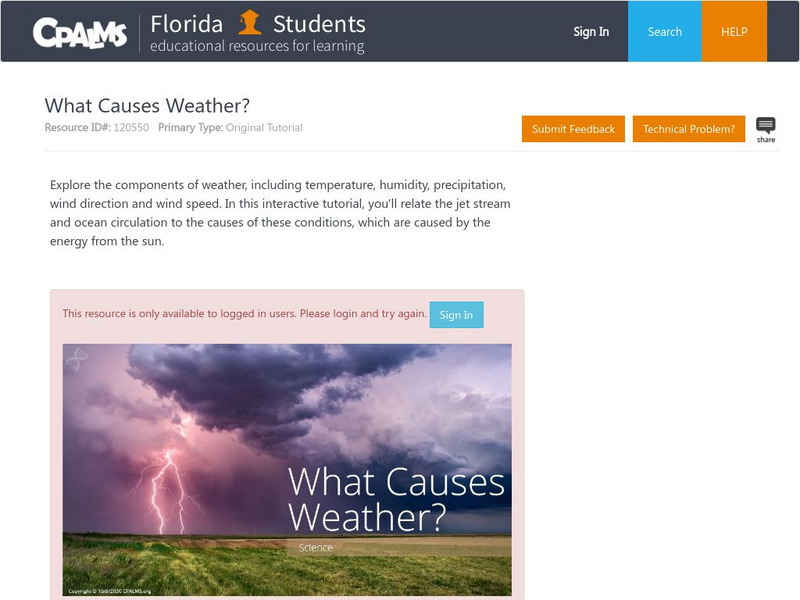Hi, what do you want to do?
Climate Literacy
Clean: Ocean Impacts on an El Nino Event
Students examine the relationships among sea surface height, sea surface temperature, and wind vectors in classifying the ocean characteristics of an El Nino.
PBS
Pbs, Secrets of the Ocean Realm: Mountain in the Sea
This experiment allows your students to study the effect of temperature on water motion and also to create their own density driven current.
Other
Bigelow Laboratory for Ocean Sciences: Salinity and Deep Ocean Currents
For this activity, students will investigate how temperature and currents affect the salinity of ocean water, making predictions after studying ocean maps. It is recommended that teachers do the experiment themselves before presenting it...
Other
Earth Science: Earth's Surface and Heat [Pdf]
This textbook chapter looks at the role of temperature in sustaining life on Earth and on weather and climate. It discusses the Earth's movements and the seasons, the circulation of the oceans, wind and weather, and the water cycle....
American Museum of Natural History
American Museum of Natural History: O Logy: Journey to Deep Sea Vents
Take a submersible down to the seafloor. As you descend, passing through the ocean's sunlight, twilight, and midnight zones, you can observe how temperature, pressure, and light levels change. When your submersible reaches the seafloor,...
Climate Literacy
Clean: Hurricanes as Heat Engines
In this activity, students examine the effects of hurricanes on sea surface temperature using NASA data. They examine authentic sea surface temperature data to explore how hurricanes extract heat energy from the ocean surface.
Science Education Resource Center at Carleton College
Serc: Density Differences
Students investigate differences in ocean water density, and record density data from salt, ice, and hot water samples in their notebooks. Students then simulate ocean water temperature levels in a simulation.
Science Buddies
Science Buddies: Harmful Algal Blooms in the Chesapeake Bay
Harmful algal blooms occur when algae, which form the base of the ocean food web, grow in massive numbers and produce toxic or harmful effects on people, fish, shellfish, marine mammals, and birds. In this project you will learn how to...
Science Buddies
Science Buddies: Can Water Float on Water?
Of course it can, you say: ice is water and ice floats. And you're right. But we're talking about water in the liquid phase Can liquid water float on water? The goal of this project is to investigate what happens to layers of water with...
Other
Nanoos: Well, Well, Well [Pdf]
This lesson provides students the opportunity to investigate the relationship between winds, surface currents, sea temperature and upwelling and downwelling off the coast of Oregon and Washington.
NOAA
Noaa: El Nino and La Nina
La Nina is characterized by unusually cold ocean temperatures in the equatorial Pacific, as compared to El Nino, which is characterized by unusually warm ocean temperatures in the equatorial Pacific. Find more general info, Forecasts,...
Encyclopedia of Earth
Encyclopedia of Earth: Global Warming Takes a Toll on Coral Reefs
Article describing damage caused to coral reefs in the Caribbean after an extended period of extreme heat in 2005 that raised the ocean temperature in that area. The potential, devastating consequences to humans of coral reef destruction...
NASA
Jet Propulsion Laboratory: Global Climate Change: Sea Level Viewer
This viewer allows you to see ocean heat storage from space. These images indicate sea surface heights. Learn more about El Nino and La Nina and how they have profound effects on world climate.
CPALMS
Florida State University Cpalms: Florida Students: What Causes Weather?
Determine parameters of weather; including specifically temperature, humidity, precipitation, wind direction and wind speed in this tutorial. During this tutorial, you will relate the jet stream and ocean circulation to the causes of...
National Geographic
National Geographic: Sources, Sinks, and Feedbacks
Students will learn about how the Earth's carbon cycle works, as they examine the relationship between levels of carbon dioxide and water vapor in the atmosphere and the temperature of the ocean's surface. Includes online student...
Scholastic
Scholastic: Study Jams! Science: Earth's Oceans
Oceans contain 97% of the water on the Earth and are home to a huge number of living creatures. View an informative slideshow of the ocean and its inhabitants and then test yourself on what you learned.
Other
Tech Learning: Students Examine Bio Diversity Nov. 2003
Read about the use of data loggers in one high school class. The data loggers were the key to quantifying the relationship between temperature, light, and biodiversity. Although this is relevant to high school science links are provided...
University of Wisconsin
Atmospheric and Oceanic Sciences: Surface Weather Analysis
Explains the use of synoptic weather analysis in preparing weather maps and forecasting. Discusses the use of symbols as well.
Georgia Department of Education
Ga Virtual Learning: Weather and Climate
In this amazingly comprehensive interactive tutorial you will learn how factors such as ocean currents, topography, and air currents affect weather patterns. You will also learn the similarities and differences between weather and climate.
University Corporation for Atmospheric Research
Ucar: What Do Soda and the Oceans Have in Common?
Students will use soda to explore how carbon dioxide is able to dissolve into liquid. They will learn about Henry's law, which describes how the solubility of gas into liquids is dependent on temperature and develop hypotheses about how...
NOAA
Noaa: Global Monsoons
This interactive world map allows you to view factors associated with monsoons. Monsoon data displayed includes factors such as precipitation, wind speed, soil moisture, and ocean temperatures. Links to monsoons associated with specific...
Curated OER
Ocean
Discover more about the underocean environment at this site that surveys animals, environmental factors such as light and temperature, currents, animals, plants, and the like.
Curated OER
Etc: Maps Etc: Mean Average Temperatures in North America, 1906
A map from 1906 of North America showing the mean annual isotherms of the region given in degrees Fahrenheit. "The climate of North America naturally varies greatly, depending on latitude, the general atmospheric circulation or direction...
HotChalk
Hot Chalk: Lesson Plans Page: Ocean Unit Introduction
This lesson will introduce young students to oceans by looking at the animals, plants and water temperatures for different oceans.






